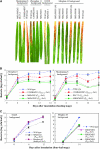The expression pattern of a rice disease resistance gene xa3/xa26 is differentially regulated by the genetic backgrounds and developmental stages that influence its function
- PMID: 17720929
- PMCID: PMC2013717
- DOI: 10.1534/genetics.107.075176
The expression pattern of a rice disease resistance gene xa3/xa26 is differentially regulated by the genetic backgrounds and developmental stages that influence its function
Abstract
Genetic background and developmental stage influence the function of some disease resistance (R) genes. The molecular mechanisms of these modifications remain elusive. Our results show that the two factors are associated with the expression of the R gene in rice Xa3 (also known as Xa26)-mediated resistance to Xanthomonas oryzae pv. oryzae (Xoo), which in turn influences the expression of defense-responsive genes. The background of japonica rice, one of the two major subspecies of Asian cultivated rice, facilitates the function of Xa3 more than the background of indica rice, another rice subspecies. Xa3 expression gradually increases from early seedling stage to adult stage. Japonica plants carrying Xa3 regulated by the native promoter showed an enlarged resistance spectrum (i.e., resistance to more Xoo races), an increased resistance level (i.e., further reduced lesion length), and whole-growth-stage resistance compared to the indica rice; this enhanced resistance was associated with an increased expression of Xa3 throughout the growth stages in the japonica plants, which resulted in enhanced expression of defense-responsive genes. Overexpressing Xa3 with a constitutive strong promoter further enhanced rice resistance due to further increased Xa3 transcripts in both indica and japonica backgrounds, whereas regulating Xa3 with a pathogen-induced weak promoter impaired rice resistance.
Figures




References
-
- Belkhadir, Y., R. Subramaniam and J. L. Dangl, 2004. Plant disease resistance protein signaling: NBS-LRR proteins and their partners. Curr. Opin. Plant. Biol. 7: 391–399. - PubMed
-
- Century, K. S., R. A. Lagman, M. Adkisson, J. Morlan, R. Tobias et al., 1999. Developmental control of Xa21-mediated disease resistance in rice. Plant J. 20: 231–236. - PubMed
-
- Chen, H., S. Wang and Q. Zhang, 2002. A new gene for bacterial blight resistance in rice located on chromosome 12 identified from Minghui 63, an elite restorer line. Phytopathology 92: 750–754. - PubMed
-
- Chern, M. S., H. A. Fitzgerald, P. E. Canlas, D. A. Navarre and P. C. Ronald, 2005. Overexpression of a rice NPR1 homolog leads to constitutive activation of defense response and hypersensitivity to light. Mol. Plant-Microbe Interact. 18: 511–520. - PubMed
Publication types
MeSH terms
Substances
LinkOut - more resources
Full Text Sources
Other Literature Sources

